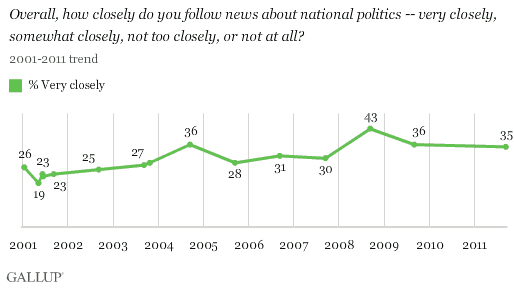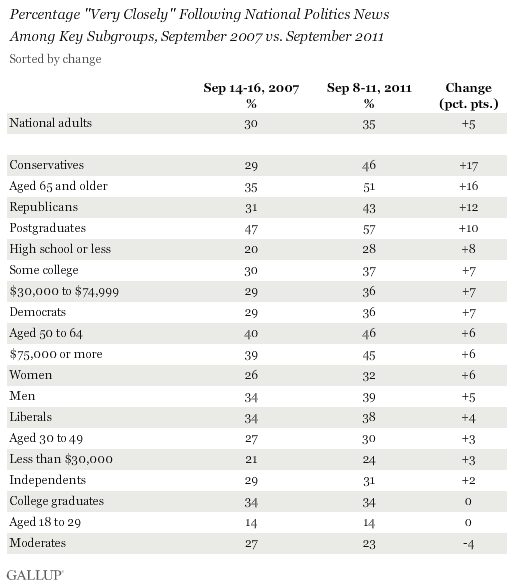WASHINGTON, D.C. -- Americans' interest in national politics is holding at the elevated level seen in 2009 after record-high attention paid in 2008. More than one in three Americans (35%) say they are following news about national politics "very closely," a greater percentage than Gallup has found in non-election years prior to 2008.

The findings are from a Gallup poll conducted Sept. 8-11, 2011. The 35% of Americans who say they are following news about national politics "very closely" is up from 30% in September 2007 and 27% in September 2003, when the nation was also 14 months away from a presidential election.
In the current survey, 45% of Americans say they are following news about national politics "somewhat closely," leaving 15% who say they are following it "not too closely" and 5% who say they are not following it at all. The combined 80% following the news very or somewhat closely this year is similar to the levels Gallup has measured since 2004.
Conservatives', Seniors' Interest Surges Most Compared With 2007
Certain groups are significantly more likely to be paying close attention to national political news today than they were at a similar time leading up to the 2008 presidential election. Conservatives, those 65 and older, Republicans, and postgraduates have all registered double-digit increases compared with September 2007. Americans aged 18 to 29 remain the least likely to say they are following national political news very closely.

Conservatives' current heightened interest in national politics essentially matches the record-high level of interest they showed in 2008, just before that year's presidential election. This is especially noteworthy, considering the 2008 survey was conducted just after the Republican National Convention that year. In contrast, liberals' and moderates' interest is down from September 2008.

Implications
More Americans are following news about national politics very closely than is typical for a non-election year. The heightened level of interest likely results from a combination of factors, including the extreme dissatisfaction with the country's direction, a high level of worry about the economy, and historic dissatisfaction with how the nation is being governed.
Conservatives and seniors are among the key constituencies paying closer attention to news about national politics than is the norm for a non-election year. Conservatives' heightened level of interest could potentially be related to the Tea Party's rise as a political force. At the same time, it is noteworthy that liberals and moderates do not show a similar uptick in interest, given the prominent news coverage of the Occupy Wall Street movement at this time.
Seniors may be keeping close tabs on the fate of their retirement benefits. Postgraduates are the only ones among the most attentive groups who express majority approval of President Obama, suggesting they may be monitoring his chances for re-election.
Whatever the causes, the current elevated level of interest in national politics could point to record interest in next year's presidential election, because interest generally increases in presidential election years. Considering the likelihood that interest in national political news and enthusiasm about voting are related, the groups paying the most attention are likely to be significant voting blocs to be reckoned with come November 2012.
Survey Methods
Results for this Gallup poll are based on telephone interviews conducted Sept. 8-11, 2011, on the Gallup Daily tracking survey, with a random sample of 1,017 adults, aged 18 and older, living in all 50 U.S. states and the District of Columbia.
For results based on the total sample of national adults, one can say with 95% confidence that the maximum margin of sampling error is ±4 percentage points.
Interviews are conducted with respondents on landline telephones and cellular phones, with interviews conducted in Spanish for respondents who are primarily Spanish-speaking. Each sample includes a minimum quota of 400 cell phone respondents and 600 landline respondents per 1,000 national adults, with additional minimum quotas among landline respondents by region. Landline telephone numbers are chosen at random among listed telephone numbers. Cell phone numbers are selected using random-digit-dial methods. Landline respondents are chosen at random within each household on the basis of which member had the most recent birthday.
Samples are weighted by gender, age, race, Hispanic ethnicity, education, region, adults in the household, and phone status (cell phone only/landline only/both, cell phone mostly, and having an unlisted landline number). Demographic weighting targets are based on the March 2010 Current Population Survey figures for the aged 18 and older non-institutionalized population living in U.S. telephone households. All reported margins of sampling error include the computed design effects for weighting and sample design.
In addition to sampling error, question wording and practical difficulties in conducting surveys can introduce error or bias into the findings of public opinion polls.
View methodology, full question results, and trend data.
For more details on Gallup's polling methodology, visit www.gallup.com.
